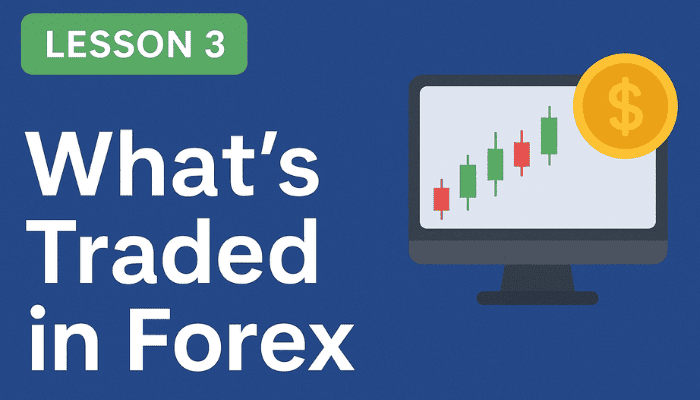
What is traded on Forex? The forex market mainly trades currencies in pairs, but many brokers also let traders access related instruments like gold (XAU), oil, indices, and CFDs.
When people talk about “forex,” they usually mean trading currencies. Currencies are always traded in pairs — for example EUR/USD (euro vs. US dollar). Each pair shows how much of the quote currency (USD) you need to buy one unit of the base currency (EUR).
- Currencies (the core of forex)
- Major pairs: These include the most traded currencies and always feature the USD. Examples: EUR/USD, USD/JPY, GBP/USD, USD/CHF, AUD/USD, USDCAD, NZD/USD. Majors have the best liquidity and usually the lowest trading costs (spreads).
- Minor (cross) pairs: Pairs that don’t include the USD, such as EUR/GBP or GBP/JPY. These can show different volatility or behavior compared to majors.
- Exotic pairs: A major currency paired with a currency from an emerging market, such as USD/TRY (US dollar/Turkish lira). Exotics can be more volatile and have wider spreads.
- Other common instruments offered by forex brokers
Many modern forex brokers let you trade more than just currency pairs. These are often offered as CFDs (Contracts for Difference) — a way to speculate on price moves without owning the actual asset. Common items include:
- Metals: Gold and silver — commonly traded as XAU/USD (gold priced in USD) and XAG/USD (silver). Gold is especially popular among forex traders as a hedge or safe-haven.
- Energy: Crude oil (Brent, WTI) — often listed as oil CFDs.
- Indices: Major stock market indexes (e.g., S&P 500, FTSE 100) — let you trade the performance of an entire market.
- Commodities: Coffee, natural gas, etc. (less common on all platforms).
- Cryptocurrencies: Some brokers offer crypto CFDs (e.g., BTC/USD), but availability and rules vary.
- Stock CFDs & ETFs: On some broker platforms you can trade individual company shares or exchange-traded funds via CFDs.
- Spot vs derivatives (short intro)
- Spot forex is trading the currency pair for immediate delivery (in practice, settlement is handled by brokers).
- Derivatives include futures, options, and CFDs — these let you bet on price moves without owning the underlying asset and often come with leverage. We’ll cover derivatives in more detail in later lessons.
- Liquidity & spreads — why the instrument matters
Not all instruments behave the same. Majors are highly liquid — many buyers and sellers are active — so spreads are tight and price moves are smoother. Exotics and some CFDs can be less liquid, leading to wider spreads and sharper price jumps. That affects trading costs and risk. - Practical example
- If you trade EUR/USD, you are speculating on the euro versus the US dollar. If the euro gains strength, EUR/USD rises and a long position makes money.
- If you trade XAU/USD (gold), you’re speculating on gold’s price in USD. Gold often reacts to inflation expectations, safe-haven demand, and movements in the US dollar.
- Quick note on regulation & availability
What your broker offers depends on their license and platform. Some brokers focus only on spot forex; others provide a full suite of CFDs across many markets. Always check which instruments a broker offers and whether they are regulated in your region.
Risk reminder
Trading different instruments changes your risk profile. Metals and indices behave differently to currencies. Always learn how an instrument behaves before trading it with real money.
Key takeaways
- The forex market primarily trades currency pairs (majors, minors/crosses, exotics).
- Many brokers also offer CFDs on metals (gold, silver), energy (oil), indices, stocks, and sometimes crypto.
- Liquidity and spreads vary by instrument — majors are usually cheapest to trade, exotics cost more.
- Instruments have different drivers (economic data, geopolitics, supply-demand), so they require different strategies and risk controls.